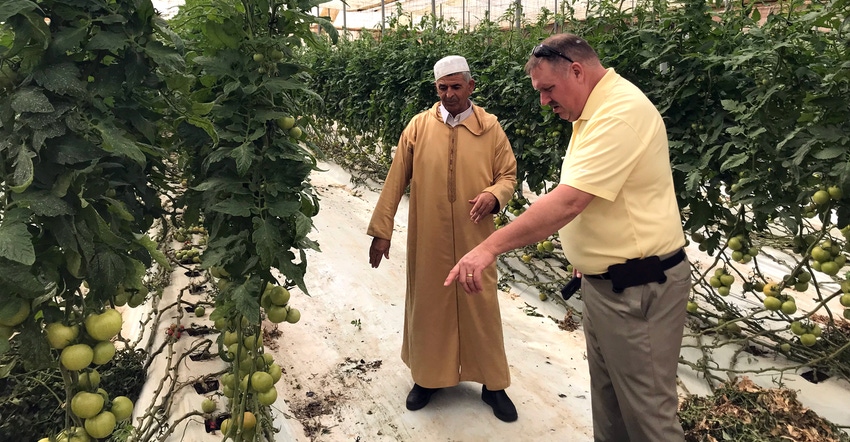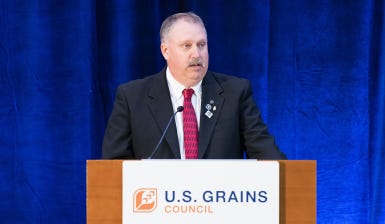
Leadership positions in county, state and national corn organizations helped prepare Chad Willis for his current post as chairman of the U.S. Grains Council.
Willis, who farms 620 acres of corn and soybeans with his wife, Krista, near Willmar, Minn., looks forward to developing and maintaining business connections in 2022, COVID-19 permitting.

AT THE HELM: Chad Willis was part of the USGC team that traveled to South Korea in mid-December.

“My theme for the year is ‘Together in Trade,’” Willis says, explaining that each new chair is responsible for coming up with an idea or concept that helps guide them in their year of leadership. “I like this one as it takes us working together. It’s all-inclusive.”
The U.S. Grains Council develops export markets for U.S. barley, corn, sorghum and related products, including dried distillers grain and ethanol. It has offices in 28 locations around the world and operates programs in more than 50 countries and the European Union. More than 140 organizations, including the state checkoff board, agribusinesses and producer groups pay annual dues to be USGC members.
Willis’ involvement in corn grower groups goes back nearly two decades. He first became involved with the county corn grower board and helped promote ethanol and other corn products. He was soon encouraged to join efforts at the state level, and was elected to the Minnesota Corn Research and Promotion Council in 2007. Since then, he has held numerous leadership roles on the state board of directors and on committees. He also served on the National Corn Growers ethanol and new uses action teams. When he was in Panama several years ago while serving on the national new uses team, Willis was asked to run for the national board of USGC.
“U.S. Grains started to focus on ethanol exports at the time,” he recalls. “I thought I could be a champion for that, so I decided to run.” Willis was elected to the 13-member board and over the next few years, served in various positions on the board of directors. He was elected to board chairman in July 2020 and will serve one year.
Trade issues in focus for 2022
Looking ahead to 2022, Willis says USGC is watching several trade issues. Closest to home is the potential impact of Mexico’s stand on glyphosate and genetically engineered corn. In December 2020, Mexico’s president signed an order that bans glyphosate and GE corn by 2024. Farm organizations in the U.S. take issue with the ban, saying the language is vague and is against the spirit and provisions of USMCA.
“We feel it’s a violation of USMCA,” Willis says. “They know they need our grain and corn.” Mexico is the second-largest U.S. corn importer and a top distillers grain buyer.
Ethanol use continues to be big globally, as countries look to reduce dependence on fossil fuels and to reduce carbon.
“Granted, Covid took down fuel use overall, but ethanol is coming back stronger,” Willis says.
U.S. ethanol had its fifth largest marketing year, with 1.22 billion gallons sold through September 2021. That’s the equivalent of 434 million bushels of corn, Willis adds.
Canada is the top U.S. ethanol importer at 28%. India is the second-largest, funneling the product into industrial use.
USGC representatives have plans to visit India in mid-January and to open an office there.
“When you look at India’s growing population, there will be a huge demand for food, protein and ethanol, and we want to be there,” Willis says. India also has a policy goal that by 2023, 20% of its ethanol will go for fuel.
Other countries that are big U.S. ethanol importers include South Korea (third-largest) and China (fourth-largest).
In fact, Willis took his first international trip as chairman to South Korea in mid-December. Other USGC directors went, too. This was the council’s first trip to Asia since the pandemic hit.
The group met with U.S. embassy personnel and members of the Agricultural Affairs Office to discuss the current relationship between the U.S. and Korea. They met with the Korea Feed Association, the Korea Corn Processing Industry Association and an animal feed manufacturer, Nonghyup Feed Inc.
By commodity, South Korea is the second-largest market for U.S. beef and beef products; the third-largest market for U.S. barley and barley products, DDGS and ethanol; and the fifth-largest market for U.S. corn, pork and pork products, according the USGC.
Building relationships
Visiting people in their home country pays off in the long run when it comes to trade. Yet, when the pandemic forced everyone to meet virtually or not at all, virtual gatherings filled a major role.
“With Zoom and technology, we were able to reach more people,” Willis notes. He sees this way of communication complementing in-person trade missions.
“It’s important to our customers to get out and visit them,” he says, adding that simple things, such as remembering names and faces can be significant, and he cited an example. Prior to becoming chair, Willis traveled to Morocco in 2018, where USGC helped with developing a cooperative dairy marketing system, build a feedlot and developed a teaching poultry center. A few years after that trip, he was at another grains-related meeting, and someone from Morocco approached him and said he remembered Willis from the USGC visit.
A possible trip to Japan might come about, too, later in 2022.
Adds Willis: “Our new CEO wants to visit overseas offices. We’ll see where we can go, due to Covid.”
About the Author(s)
You May Also Like






